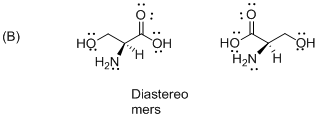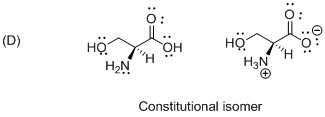
Concept explainers
(a)
Interpretation:
The given compound should be filled whether it is resonance structure, constitutional isomer, cis/trans isomer or same structure.
Concept introduction:
Isomer: Molecule has same molecular formula but different structural arrangement is called isomer.
Geometric isomerism (also known as E-Z isomerism or cis-trans isomerism): same molecular formula but different arrangement in the space. These isomers happen where you have restricted rotation in a molecule (double bond in the molecule). The
Constitutional isomer: (or structural) isomers differ in the connectivity they contain different functional groups and / or bonding patterns is called constitutional isomer.
Resonance: it is a process of delocalization electrons with in the molecule.
Chiral: Absence of a plane of symmetry or a center of symmetry is called chiral molecule, a non-superimposable on its mirror image is called chiral. A carbon atom is attached by the four different groups is called chiral carbon.
Enantiomers: Two stereoisomers that are mirror images of each other and they are non-supposable.
Diastereomers: Two stereoisomers that are non-mirror images of each other and they are non-supposable.
(a)
Answer to Problem 23.86QP
The given compound is diastereomers (a)
Explanation of Solution
To find: The given compound is resonance structure, constitutional isomer, cis/trans isomer or same structure
The given compound is resonance structure, constitutional isomer, cis/trans isomer or same structure needs to be known.
The given compound is diastereomers which is shown below.

The above compounds are non-mirror images of each other and they are non-supposable therefore the given compound diastereomers.
(b)
Interpretation:
The given compound should be filled whether it is resonance structure, constitutional isomer, cis/trans isomer or same structure.
Concept introduction:
Isomer: Molecule has same molecular formula but different structural arrangement is called isomer.
Geometric isomerism (also known as E-Z isomerism or cis-trans isomerism): same molecular formula but different arrangement in the space. These isomers happen where you have restricted rotation in a molecule (double bond in the molecule). The functional groups are same side in the molecule is cis, the functional groups are opposite side is called trans isomer.
Constitutional isomer: (or structural) isomers differ in the connectivity they contain different functional groups and / or bonding patterns is called constitutional isomer.
Resonance: it is a process of delocalization electrons with in the molecule.
Chiral: Absence of a plane of symmetry or a center of symmetry is called chiral molecule, a non-superimposable on its mirror image is called chiral. A carbon atom is attached by the four different groups is called chiral carbon.
Enantiomers: Two stereoisomers that are mirror images of each other and they are non-supposable.
Diastereomers: Two stereoisomers that are non-mirror images of each other and they are non-supposable.
(b)
Answer to Problem 23.86QP
The given compound is diastereomers (b)
Explanation of Solution
To find: The given compound is resonance structure, constitutional isomer, cis/trans isomer or same structure
The given compound is resonance structure, constitutional isomer, cis/trans isomer or same structure needs to be known.
The given compound is diastereomers which is shown below.

The above compounds are non-mirror images of each other and they are non-supposable therefore the given compound diastereomers.
(c)
Interpretation:
The given compound should be filled whether it is resonance structure, constitutional isomer, cis/trans isomer or same structure.
Concept introduction:
Isomer: Molecule has same molecular formula but different structural arrangement is called isomer.
Geometric isomerism (also known as E-Z isomerism or cis-trans isomerism): same molecular formula but different arrangement in the space. These isomers happen where you have restricted rotation in a molecule (double bond in the molecule). The functional groups are same side in the molecule is cis, the functional groups are opposite side is called trans isomer.
Constitutional isomer: (or structural) isomers differ in the connectivity they contain different functional groups and / or bonding patterns is called constitutional isomer.
Resonance: it is a process of delocalization electrons with in the molecule.
Chiral: Absence of a plane of symmetry or a center of symmetry is called chiral molecule, a non-superimposable on its mirror image is called chiral. A carbon atom is attached by the four different groups is called chiral carbon.
Enantiomers: Two stereoisomers that are mirror images of each other and they are non-supposable.
Diastereomers: Two stereoisomers that are non-mirror images of each other and they are non-supposable.
(c)
Answer to Problem 23.86QP
The given compound is resonance structure (c)
Explanation of Solution
To find: The given compound is resonance structure, constitutional isomer, cis/trans isomer or same structure
The given compound is resonance structure, constitutional isomer, cis/trans isomer or same structure needs to be known.
The given compound is resonance structure which is shown below.

Isomers have different sequence of bond types or connection in different order is called as resonance structure therefore the given molecule is resonance structure.
(d)
Interpretation:
The given compound should be filled whether it is resonance structure, constitutional isomer, cis/trans isomer or same structure.
Concept introduction:
Isomer: Molecule has same molecular formula but different structural arrangement is called isomer.
Geometric isomerism (also known as E-Z isomerism or cis-trans isomerism): same molecular formula but different arrangement in the space. These isomers happen where you have restricted rotation in a molecule (double bond in the molecule). The functional groups are same side in the molecule is cis, the functional groups are opposite side is called trans isomer.
Constitutional isomer: (or structural) isomers differ in the connectivity they contain different functional groups and / or bonding patterns is called constitutional isomer.
Resonance: it is a process of delocalization electrons with in the molecule.
Chiral: Absence of a plane of symmetry or a center of symmetry is called chiral molecule, a non-superimposable on its mirror image is called chiral. A carbon atom is attached by the four different groups is called chiral carbon.
Enantiomers: Two stereoisomers that are mirror images of each other and they are non-supposable.
Diastereomers: Two stereoisomers that are non-mirror images of each other and they are non-supposable.
(d)
Answer to Problem 23.86QP
The given compound is constitutional isomer (d)
Explanation of Solution
To find: The given compound is resonance structure, constitutional isomer, cis/trans isomer or same structure
The given compound is resonance structure, constitutional isomer, cis/trans isomer or same structure needs to be known.
The given compound is constitutional isomer which is shown below.

Isomers with the same order of connections and sequence of bond types, but which differ in the spatial arrangement of the atoms therefore the given molecule is called constitutional isomer
Want to see more full solutions like this?
Chapter 23 Solutions
CHEMISTRY:ATOMS FIRST (LL)>CUSTOM PKG.<
- CUE COLUMN NOTES (A. Determine Stereoisomers it has ⑤ Identify any meso B compounds cl Br cl -c-c-c-c-¿- 1 CI C- | 2,4-Dichloro-3-bromopentanearrow_forwardThe acid-base chemistry of both EDTA and EBT are important to ensuring that the reactions proceed as desired, thus the pH is controlled using a buffer. What percent of the EBT indicator will be in the desired HIn2- state at pH = 10.5. pKa1 = 6.2 and pKa2 = 11.6 of EBTarrow_forwardWhat does the phrase 'fit for purpose' mean in relation to analytical chemistry? Please provide examples too.arrow_forward
- For each of the substituted benzene molecules below, determine the inductive and resonance effects the substituent will have on the benzene ring, as well as the overall electron-density of the ring compared to unsubstituted benzene. Molecule Inductive Effects Resonance Effects Overall Electron-Density × NO2 ○ donating O donating O withdrawing O withdrawing O electron-rich electron-deficient no inductive effects O no resonance effects O similar to benzene E [ CI O donating withdrawing O no inductive effects Explanation Check ○ donating withdrawing no resonance effects electron-rich electron-deficient O similar to benzene © 2025 McGraw Hill LLC. All Rights Reserved. Terms of Use | Privacy Center Accesarrow_forwardUnderstanding how substituents activate Rank each of the following substituted benzene molecules in order of which will react fastest (1) to slowest (4) by electrophilic aromatic substitution. Explanation HN NH2 Check X (Choose one) (Choose one) (Choose one) (Choose one) © 2025 McGraw Hill LLC. All Rights Reserved. Terms of Use | Privacy Center Aarrow_forwardIdentifying electron-donating and electron-withdrawing effects on benzene For each of the substituted benzene molecules below, determine the inductive and resonance effects the substituent will have on the benzene ring, as well as the overall electron-density of the ring compared to unsubstituted benzene. Inductive Effects Resonance Effects Overall Electron-Density Molecule CF3 O donating O donating O withdrawing O withdrawing O no inductive effects O no resonance effects electron-rich electron-deficient O similar to benzene CH3 O donating O withdrawing O no inductive effects O donating O withdrawing Ono resonance effects O electron-rich O electron-deficient O similar to benzene Explanation Check Х © 2025 McGraw Hill LLC. All Rights Reserved. Terms of Use | Privacy Centerarrow_forward
- * Hint: Think back to Chem 1 solubility rules. Follow Up Questions for Part B 12. What impact do the following disturbances to a system at equilibrium have on k, the rate constant for the forward reaction? Explain. (4 pts) a) Changing the concentration of a reactant or product. (2 pts) b) Changing the temperature of an exothermic reaction. (2 pts) ofarrow_forwardDraw TWO general chemical equation to prepare Symmetrical and non-Symmetrical ethers Draw 1 chemical reaction of an etherarrow_forwardPlease help me with the following questions for chemistry.arrow_forward
 Chemistry: Principles and PracticeChemistryISBN:9780534420123Author:Daniel L. Reger, Scott R. Goode, David W. Ball, Edward MercerPublisher:Cengage Learning
Chemistry: Principles and PracticeChemistryISBN:9780534420123Author:Daniel L. Reger, Scott R. Goode, David W. Ball, Edward MercerPublisher:Cengage Learning Organic And Biological ChemistryChemistryISBN:9781305081079Author:STOKER, H. Stephen (howard Stephen)Publisher:Cengage Learning,
Organic And Biological ChemistryChemistryISBN:9781305081079Author:STOKER, H. Stephen (howard Stephen)Publisher:Cengage Learning, General, Organic, and Biological ChemistryChemistryISBN:9781285853918Author:H. Stephen StokerPublisher:Cengage Learning
General, Organic, and Biological ChemistryChemistryISBN:9781285853918Author:H. Stephen StokerPublisher:Cengage Learning Chemistry for Today: General, Organic, and Bioche...ChemistryISBN:9781305960060Author:Spencer L. Seager, Michael R. Slabaugh, Maren S. HansenPublisher:Cengage Learning
Chemistry for Today: General, Organic, and Bioche...ChemistryISBN:9781305960060Author:Spencer L. Seager, Michael R. Slabaugh, Maren S. HansenPublisher:Cengage Learning World of Chemistry, 3rd editionChemistryISBN:9781133109655Author:Steven S. Zumdahl, Susan L. Zumdahl, Donald J. DeCostePublisher:Brooks / Cole / Cengage Learning
World of Chemistry, 3rd editionChemistryISBN:9781133109655Author:Steven S. Zumdahl, Susan L. Zumdahl, Donald J. DeCostePublisher:Brooks / Cole / Cengage Learning





